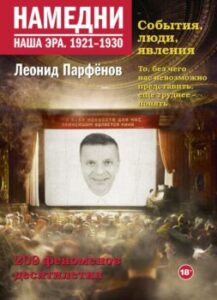Описание книги
About product New book of the legendary project of Leonid Parfyonov «Namedni». A bright, colorful and informative journey to the origins of the Soviet state. Electrification and industrialization, collectivization and dispossession of kulaks, «The Man with a Movie Camera» and «Battleship Potemkin», a meeting with Alexei Tolstoy and farewell to Alexander Blok, «Quiet Don» and «12 Chairs» , the suicide of Mayakovsky and Yesenin, the departure of Gorky and the execution of Gumilyov, the Kronstadt uprising and famine in the Volga region, the worst in the history of Russia, Bulgakov’s «Days of the Turbins» at the Moscow Art Theater and Sergei Prokofiev’s symphonic tale «Peter and the Wolf» at the Children’s Theater by Natalia Sats answer to Chamberlain «and» Nowhere but in Mosselprom «; the post of General Secretary of the Central Committee of the RCP (b) is occupied by Joseph Stalin, and Chaplin’s films are shown triumphantly in the film distribution, a Mausoleum is being erected on Red Square, and the Solovetsky Monastery is turning into a camp. In this turbulent decade, the country was often thrown from one extreme to another, remember at least about the New Economic Policy, NEP — an attempt to introduce a capitalist component into the economy. This will be the time of dawn and dusk of the avant-garde in art. Pathfinding time. And, ultimately, the time of the birth of that very socialism, with which the country, in one way or another, will exist for almost the entire XX century. Abstract The book «The other day. Our era. 1921–1930», the new ninth volume of the legendary project, clearly shows how the phenomenon arose, to which most of the subsequent volumes are devoted — socialism. How the old life collapsed, how the age-old foundations broke, the ties that once seemed so strong were torn and a new world was built on the rubble of the past. How the language of avant-garde culture arose, how great novels, beautiful poems and phenomenal films were created. How gradually this language was brought to naught by the censorship and the omnipresent hand of the party. How they introduced and then fought mercilessly against the NEP. How leaderism was born and the bloody and irreconcilable internal party struggle went on, which became especially acute after the death of Lenin. How jazz and thug song came into urban fashion. How the first payphones and traffic lights appear. How huge enterprises and entire industries are launched. How the Solovetsky Monastery becomes a «corrective labor» camp and a Gulag appears. …
FAQ
